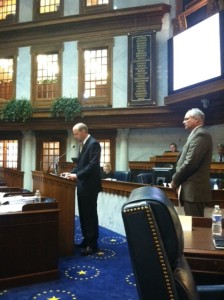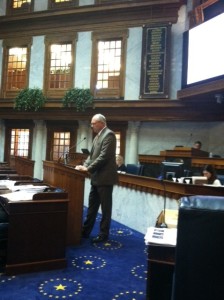This quote seems very timely given that I am currently attending the Indiana Michigan Power Integrated Resource Plan (IRP) meeting today (9/18/13) in Indianapolis.
"Utility executives, meanwhile, are asking themselves a disquieting question: "Am I going to just sit here and take it and ultimately be a caretaker of a museum, or am I going to be part of that business" that's emerging, said Nick Akins, chief executive of American Electric Power Co., AEP -0.02% a big Ohio-based utility. AEP is considering helping its customers install their own generating facilities."
Companies Unplug From the Electric Grid, Delivering a Jolt to Utilities
CASSANDRA SWEET
![[image]](http://si.wsj.net/public/resources/images/P1-BN178_OWNGEN_G_20130917184748.jpg) Michal Czerwonka for The Wall Street JournalAt Kroger's food-distribution center in Compton, Calif., a tank system converts organic waste into biogas to produce electricity used by the facility
Michal Czerwonka for The Wall Street JournalAt Kroger's food-distribution center in Compton, Calif., a tank system converts organic waste into biogas to produce electricity used by the facility
On a hill overlooking the Susquehanna River, two big wind turbines crank out electricity for Kroger Co.'s KR -0.64% Turkey Hill Dairy in rural Lancaster County, Pa., allowing it to save 25% on its power bill for the past two years.
Across the country, at a big food-distribution center Kroger also owns in Compton, Calif., a tank system installed this year uses bacteria to convert 150 tons a day of damaged produce, bread and other organic waste into a biogas that is burned on site to produce 20% of the electricity the facility uses.
These two projects, plus the electric output of solar panels at four Kroger grocery stores, and some energy-conservation efforts are saving the Cincinnati-based grocery chain $160 million a year on electricity, said Denis George, its energy manager. That is a lot of money that isn't going into the pockets of utilities.
From big-box retailers to high-tech manufacturers, more companies across the country are producing their own power. Since 2006, the number of electricity-generation units at commercial and industrial sites has more than quadrupled to roughly 40,000 from about 10,000, according to federal statistics.
Experts say the trend is gaining momentum, spurred by falling prices for solar panels and natural gas, as well as a fear that power outages caused by major storms will become more common.
Michal Czerwonka for The Wall Street JournalOrganic waste
"The battle cry is Hurricane Sandy," said Rick Fioravanti, vice president of energy-storage technology at DNV Kema, a Netherlands-based consulting company.
The growing number of companies that are at least partly energy self-sufficient is sending a shudder through the utility industry, threatening its revenues and growth prospects, according to a report earlier this year by the Edison Electric Institute, a trade association for investor-owned electric companies.
State and federal regulators say they are worried that utilities could end up with fewer customers to pay for costly transmission lines and power plants.
Utility executives, meanwhile, are asking themselves a disquieting question: "Am I going to just sit here and take it and ultimately be a caretaker of a museum, or am I going to be part of that business" that's emerging, said Nick Akins, chief executive of American Electric Power Co., AEP -0.07% a big Ohio-based utility. AEP is considering helping its customers install their own generating facilities.
On-site generation still accounts for less than 5% of U.S. electricity production. But it is peeling off some of the bulk sales that utilities find especially profitable. And some of the companies getting into the business think it is approaching a tipping point called "grid parity," at which point power would be as cheap to make as to buy from a utility.
Since 2007, when the first solar arrays went up on its store roofs in California, the installed costs of Wal-Mart Stores Inc.'s WMT -0.11% solar systems have dropped from $6 or $8 per watt of capacity to about $3.50 per watt, said David Ozment, the company's senior director of energy management. He said he expects the retailer to be paying as little for solar power as utility power "in less than three years," opening the floodgates to solar expansion.
Wal-Mart produces about 4% of the electricity it uses but intends to make 20% by 2020, taking advantage of idle acreage on thousands of store rooftops.
On-site generation isn't a new idea. It existed before the electric grid—the interconnected system of power plants, substations and transmission lines that ferry power thousands of miles—was stitched together beginning in the 1920s.
But for most of the past 50 years, the practice was associated mostly with remote locations like Alaska fish canneries or industrial facilities like oil refineries that generated lots of waste heat that could be harnessed for power production.
Almost overnight, that niche market has gone decidedly mainstream. Six years ago ,Google Inc. GOOG -0.06% attracted attention by installing big solar arrays atop its Silicon Valley complex in California. Other tech companies followed suit, worried about ensuring power supplies for energy-hungry server farms and achieving sustainability objectives.
Apple Inc. AAPL +2.08% now gets 16% of its electricity from solar panels and fuel cells that run on biogas. Apple's data center in Maiden, N.C., makes all the power it consumes, a company spokeswoman said.
BMW AG's BMW.XE -0.22% assembly plant in South Carolina, which made 300,000 vehicles last year, gets half its electricity from an on-site energy center that burns methane piped to it from a nearby garbage dump. Drugstore chain Walgreen Co.,WAG +0.24% which has solar panels at 155 stores, plans to install them at 200 more.
Falling equipment prices make on-site generation increasingly attractive. From 2002 to 2012, the cost of installed solar systems fell by half, according to an August report from the Lawrence Berkeley National Lab. Companies also have the option of leasing big solar systems, rather than incurring the capital cost of buying them.
Many "clean energy" projects also qualify for federal and state subsidies. In the case of solar installations, there is a 30% federal tax credit, which is set to drop to 10% in 2017. Government officials say a shift to greener energy resources is good since it reduces the output from coal-fueled power plants, which produce about 40% of the nation's electricity and are the most polluting.
But analysts say the importance of subsidies has been waning, overshadowed by steep declines in the cost of power-generating equipment. For example, the cost of solar modules—the biggest single component in a rooftop solar system—has dropped about 80% in the past four years, to about 65 cents a watt from about $4 a watt, said Galen Barbose, a senior researcher at the lab.
Companies also are turning to wind turbines and technologies like fuel cells, batteries, small natural-gas turbines and reciprocating engines, which are natural-gas-fueled cousins of the auto's internal combustion engine.
Engineering and technology company SAIC Inc. SAI -0.13% is installing enough generating capacity at a data center outside New York to meet the center's core needs, with batteries for backup power. The system uses reciprocating engines burning natural gas, an option considered reliable in storms because gas pipelines are buried.
A report released by the White House in August estimated that power outages caused by bad weather cost the U.S. economy $18 billion to $52 billion a year in lost productivity from 2003 to 2012.
Demand for fuel cells in the U.S. is coming primarily from telecom companies, hotels and universities, said David Wright, CEO of ClearEdge Power Inc., a manufacturer in Hillsboro, Ore. Many buyers want reliable on-site generation as a hedge against storm-related outages.
By next year, Verizon Communications Inc. VZ -0.54% plans to install $100 million worth of fuel cells from ClearEdge and Bloom Energy, as well as solar panels, at 19 data centers and other facilities in seven states, including New York and New Jersey.
Some traditional utility companies are edging into the on-site generation business.
Edison International, EIX +0.15% which owns big utility Southern California Edison, recently bought a Chicago-based developer of rooftop solar projects, SoCore Energy LLC, and it is an investor in solar-finance company Clean Power Finance.
As power production becomes more decentralized, "I want to make sure the company is deeply involved," said Edison CEO Ted Craver.
Write to Rebecca Smith at rebecca.smith@wsj.com and Cassandra Sweet atcassandra.sweet@dowjones.com
![]() goals.
goals.![]() in the region, state officials said.
in the region, state officials said.![]() Most will be imported into the state, the Maine wind project providing 250 megawatts to the in-state solar project's 20.In Aroostook County, Maine, EDP Renewables North America will build a 250-megawatt wind farm, called the Number Nine Wind Farm, on 94 acres of private land used now for timber production.
Most will be imported into the state, the Maine wind project providing 250 megawatts to the in-state solar project's 20.In Aroostook County, Maine, EDP Renewables North America will build a 250-megawatt wind farm, called the Number Nine Wind Farm, on 94 acres of private land used now for timber production.![]() Hill Road. In its application, the company said it has secured financing from an unnamed Fortune 500 utility.
Hill Road. In its application, the company said it has secured financing from an unnamed Fortune 500 utility.![]() that expires at the end of the year. Others include scale and competition, according to officials.
that expires at the end of the year. Others include scale and competition, according to officials.![]() — all at a cost comparable to electricity generated from conventional power plants," Gov. Dannel P. Malloy said in a written statement.
— all at a cost comparable to electricity generated from conventional power plants," Gov. Dannel P. Malloy said in a written statement.




![[image]](http://si.wsj.net/public/resources/images/P1-BN178_OWNGEN_G_20130917184748.jpg) Michal Czerwonka for The Wall Street Journal
Michal Czerwonka for The Wall Street Journal
